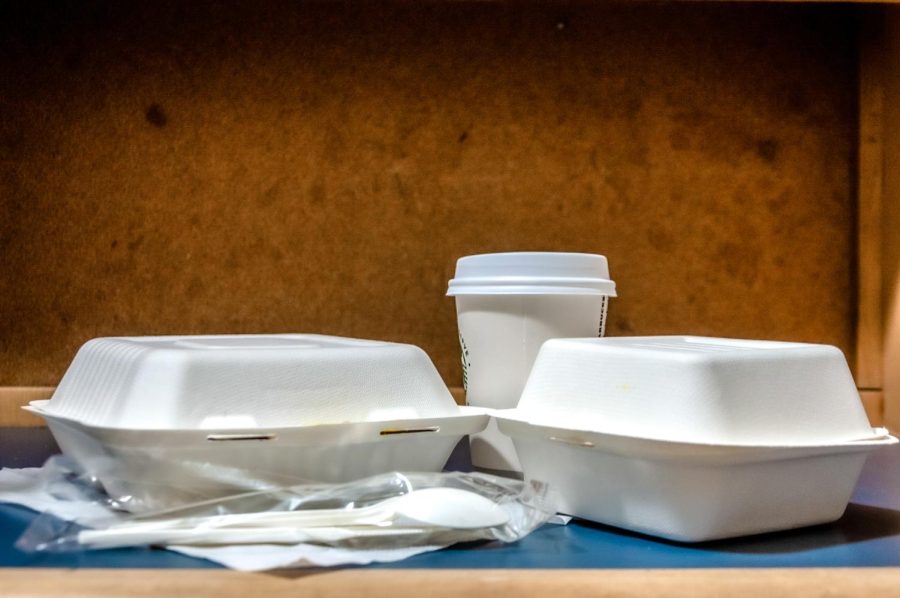Opinion: NYU Eats Grab & Go should be more eco-friendly
The Grab & Go system at NYU’s dining halls creates excessive waste and must become more environmentally sustainable.
NYU dining halls’ take-out packaging has accelerated plastic consumption at NYU. (Photo by Kiran Komanduri)
February 10, 2022
The Grab & Go option is offered at all 14 NYU Eats locations and allows students to take food from the dining hall with single-use plastic containers and utensils. The United States uses nearly one trillion single-use food packages per year. Given NYU’s size, it is time for the Grab & Go policy to become more eco-friendly.
According to Kathrina O’Mahony, senior director of campus services, NYU Eats’ take-out products are compostable. The issue is that students often leave the dining halls and take their items elsewhere. According to NYU’s website, compost collection is available in NYU dining halls and the Kimmel Center for University Life. Thus, students eating in residence halls without a dining hall, for example, would have to seek out a city-wide drop-off site to properly dispose of their food containers. If containers cannot be properly composted, they could end up in landfills, where compostable materials are often unable to undergo the natural decomposition process. Landfills are oftentimes airtight, sealed environments and the composting process requires oxygen to reap any of its intended benefits. This means that, unfortunately, compostable does not always equal sustainable.
“Last semester, we also began piloting the Ozzi Reusable Container system in two dining locations, Third North and Downstein,” said O’Mahony.
This system should exist at more than two out of 14 locations and should be made more accessible.
“I have never seen anyone use them,” said first-year Edie Peffley in reference to the Ozzi containers. “They have never instructed us on how to get them.”

While O’Mahony says that these containers were put on hold during the temporary suspension of dine-in services, which began in late December and ended in early February, there was little to no marketing of the reusable containers in the months leading up to, or days following, the restrictions. Single-use containers are still offered as the default for Grab & Go.
“When seating resumes in our dining locations, we will restore the use of [dine-in] china and silverware in all of our residential locations,” O’Mahoney said.
However, should the china and silverware in dining halls be deemed safe, there is no reason why reusable containers designed for take-out should not be offered in all dining locations as well.
O’Mahony said that Campus Services has implemented a variety of tools to decrease waste in the dining halls, such as implementing Perfect Sugar Serve dispensers in all dining locations. In doing so, they have prevented approximately 20,000 single-serve sugar packets from entering NYU’s waste stream per week per dining location.
Campus Services also put condiments into dispensers as opposed to individual packets. While these actions are positive advancements, they do not address the issue of Grab & Go — an extremely popular dining choice for students that has created waste around the university.
NYU Eats’ lack of compost collection sites is antithetical to its commitment to sustainability and must be adjusted. NYU Eats should expand its reusable containers to all locations and market them rather than the single-use ones. NYU could also implement more collection-based disposal services in dorms, outdoor seating areas and other common areas where students typically eat take-out. This would allow for mixed recycling, landfill, compost and other types of waste to be disposed of and sorted in the most environmentally sustainable manner.
While hoping that NYU’s policies will improve, students should make an effort to reach a collection-based disposal site and sort their products accordingly — some dining halls like Kimmel have signs to guide them through this process. This, coupled with NYU promoting more eco-friendly take-out and disposal options, would be a step in the right direction. With a $5.8 billion endowment fund, NYU has the resources and ability to become more sustainable in the face of deadly climate change — it is just a matter of whether the university chooses to take on that responsibility.
Contact Grace Homan at [email protected].
























































































































































